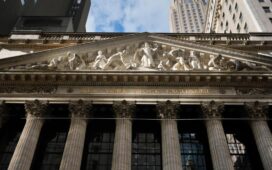The global economy stands at a unique crossroads at the end of 2023. The coronavirus health crisis is no longer an active pandemic, but its aftershocks will continue to reshape the world for years to come. At the same time, decades of unstoppable innovations are bearing fruit right now, with game-changing consequences across many business sectors.
The stock market is adjusting to these structural changes, driving the S&P 500 index a dividend-adjusted 26% higher in 2023 after an 18% drop in 2022.
Let me be clear. Investors should take a fresh look at macroeconomic trends every year. December is a good time to rebalance your investment portfolio, make tax-management moves, and generally ensure you’re in good shape for the next year. But the tail end of 2023 magnifies the typical need for adjustment. There is so much going on, with a mix of problems and opportunities around every corner.
I’m not alone in this assessment.
In its year-end market review, Swiss investing firm Julius Bär notes that the world “might be on the cusp of an innovation super cycle driven by the convergence of multiple technologies.” Financial giant BlackRock agrees in its own annual market report: This moment is “not the typical business cycle” but a unique opportunity to find market-beating stocks through active financial analysis. And JPMorgan sees “a world in transition” to more traditional fiscal policy but downright revolutionary trends in energy consumption and new technologies.
It doesn’t take much money to invest in these massive trends. If you can afford to set aside $100 today, you could follow up with another $100 in January and so on. Over time, your commitment should result in serious wealth-building investments. So, let me show you three of the most disruptive megatrends in today’s market and how your investing strategy can take advantage of these long-term sea changes.
Artificial intelligence (AI)
I’m not trying to surprise you here, dear reader. You saw the AI juggernaut coming from a mile away, and there’s no stopping it now.
When OpenAI released the ChatGPT tool a year ago, that move sparked a worldwide fascination with AI systems. As it turns out, ChatGPT is just the tip of a much larger AI iceberg. Computers have dominated logic-based domains, such as simple math and world-class chess, for years, but now they can take on more creative jobs.
Generative AI comes in many flavors. ChatGPT can write text and carry on conversations with a nearly human feel. Platforms like Midjourney and DALL-E generate images based on simple text descriptions. Google parent Alphabet provides several ways to make AI-powered music without ever touching an instrument. However, AI-based chatbots arguably offer the greatest business benefits in this diverse collection.
That’s why Microsoft is building ChatGPT into the classic MS Office Suite and the Bing search engine. Google may have a plethora of generative AI tools in its bag, but the simple Bard chatbot inspires more headlines than its digital cousins.
If you want to focus on the lasting value of business-to-business services, you should take a closer look at International Business Machines (IBM -0.04%) and C3.ai. And, of course, Nvidia is an early leader in AI accelerator hardware, though Advanced Micro Devices and Intel are introducing AI chips of comparable power.
These AI experts are turning entire industries upside down, and there’s no going back. The companies mentioned are all innovators and leaders in this emerging field. Seven of these eight stocks have posted price jumps of 55% or more, and Nvidia’s shares have more than tripled. Finding the right balance between lofty valuations and stellar long-term growth prospects is the opportunity BlackRock was talking about.
IBM stands out as an affordable AI play with a year-to-date gain of just 14%. Market makers appear to have forgotten Big Blue’s long history of high-performance computing. This stock is a good place to start if you’re excited about the AI market but worried about buying into a bubble.
Renewable energy
One of the core “transitions” in JPMorgan’s sights is the move from fossil fuels to alternative energy sources. The ball is already rolling, and there’s no end in sight to this disruptive shift.
Investors can tap into this megatrend from several angles. For example, NextEra Energy (NEE -0.89%) has a world-class portfolio of solar and wind power assets, with an even stronger pipeline of firm orders for future projects. Electric vehicles are everywhere, going far beyond the market shift that Tesla started years ago. Elon Musk’s company is also a major player in alternative energy, with market-leading solutions in solar power and energy storage.
And you can’t forget about the classical energy giants, either. ExxonMobil (XOM 0.03%), for instance, is developing carbon capture technologies and lower-carbon biofuels to ensure a solid future in the post-oil era of global energy.
Many alternative energy stocks took dramatic haircuts recently as rising interest rates reduced the demand for expensive solar or wind energy projects. Solar panel giant First Solar‘s (FSLR 2.81%) stock is down by 10% in the last six months, and micro-inverter expert Enphase Energy (ENPH 4.31%) took a 23% hit over the same period.
Some next-generation energy innovators will surely soar in the long run, making a buying opportunity out of this deep dip, but others will just as surely fail. I’m no authority on energy stocks, but fellow Fool (and actual energy expert) Travis Hoium highlights First Solar and Enphase as potential turnaround plays right now. His analysis is just about the best place to start investigating traditional and forward-looking energy ideas.
Cryptocurrency
So, let’s turn to another area where I do wield some expertise. The crypto winter that started in 2021 is thawing out, 2024 looks like a year of pivotal progress for crypto investments, and the concept of long-term value in newfangled digital currencies is catching on.
The next year or so should deliver the goods on several long-awaited crypto catalysts. For instance:
- The work required to mint a new Bitcoin (CRYPTO: BTC) token will double in April, with game-changing effects on the economics of Bitcoin mining. The mining effort makes sense only if the expected output is worth more than the energy costs, and the Bitcoin blockchain can’t process transactions if the mining stops. Therefore, token prices should at least double in response to the fourth so-called “halvening,” as they did in the first three instances. The effect isn’t immediate but should develop over several months. So, it’s double or bust every time this supply-side event takes place, and I don’t expect this digital asset (currently worth $855 billion) to go away this quickly.
- There’s more Bitcoin news on the way. Several financial giants have filed the paperwork to create Bitcoin-based exchange-traded funds (ETFs). The Securities and Exchange Commission (SEC) is dragging its feet on approving (or even considering) any of these filings, but the agency is now under a legal requirement to do something by January 10, 2024. Approving one request should result in a plethora of Bitcoin ETFs all at once because the alternative would give an unfair advantage to the recipient of the first approval. The resulting influx of dollar-based capital in the Bitcoin world could bring monumental price increases.
- The long-running Securities and Exchange Commission v. Ripple Labs lawsuit is only partially completed. The regulator’s complaints regarding Ripple‘s (XRP 0.81%) sales to private persons have ended, but there will be a jury trial regarding Ripple’s launch among institutional investors. Trial dates are currently up in the air, but the proceedings should play out in the second half of 2024. Whatever happens in that New York courtroom will give crypto investors greater clarity on the legal and regulatory rule book for digital currencies.
Of course, the volatile crypto sector is always prone to surprises. Apart from the hard-coded Bitcoin halvening, these catalysts are subject to human whims, potential delays, and maybe even cancellations. That said, crypto investors are looking forward to several promising events next year, and the sector’s long-term future still looks bright.
I don’t recommend moving all your money into Bitcoin (or any other single asset, from gold to single-name stock tickers). Still, some exposure to the crypto market is starting to look necessary.
If you’re uncomfortable opening a cryptocurrency brokerage account and don’t want to wait for a proper Bitcoin ETF, you could always lean on the Grayscale Bitcoin Trust (GBTC 0.84%). This Bitcoin-owning mutual fund currently trades at an 8% discount to the market value of its assets and is under consideration for conversion into an ETF.
JPMorgan Chase is an advertising partner of The Ascent, a Motley Fool company. Suzanne Frey, an executive at Alphabet, is a member of The Motley Fool’s board of directors. Anders Bylund has positions in Alphabet, Bitcoin, Grayscale Bitcoin Trust (BTC), Intel, International Business Machines, Nvidia, and XRP. The Motley Fool has positions in and recommends Advanced Micro Devices, Alphabet, Bitcoin, Enphase Energy, JPMorgan Chase, Microsoft, NextEra Energy, Nvidia, Tesla, and XRP. The Motley Fool recommends C3.ai, First Solar, Intel, and International Business Machines and recommends the following options: long January 2023 $57.50 calls on Intel, long January 2025 $45 calls on Intel, and short February 2024 $47 calls on Intel. The Motley Fool has a disclosure policy.





